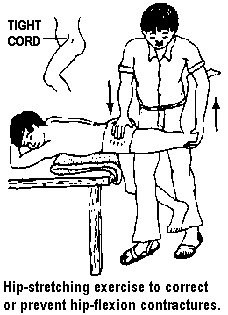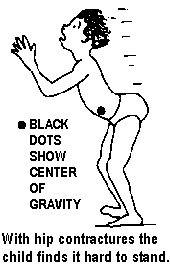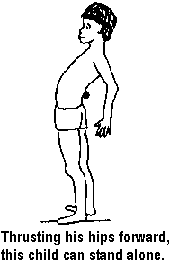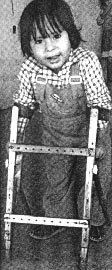A Low-Cost Crutch-Walker for Lino

LINO, like Beno, was born with spina bifida. The
defect in his spinal cord was sufficiently low on his back (near his
butt) that he had fair upper leg strength. This meant he had a good
chance of learning to walk, first perhaps with a standing board (parapodium)
and then with a walker and perhaps crutches.

If a child with spina bifida is to be able to walk with crutches, or
possibly without them, it is important that, from early childhood, every
effort be made to prevent hip-flexion contractures. Care should be taken
to keep the hip joints extended as straight as possible by means of
exercises, positioning, and appropriate assistive devices.


Because of weak lower back and hip muscles, the child with spina
bifida is likely to find it hard to stand independently.
Some of these children learn to stand by thrusting their hips forward
and their upper body backwards, so that their center of gravity is
behind the hips. But to stand this way, it is essential that hip-flexion
contractures be prevented (or corrected). In fact, it helps if
the hip joints over-extend, or bend farther back than a simply
straight position.
Lino was fortunate because, since early childhood, his family helped
with exercises and positioning to keep his hips fully flexible. When he
was three, PROJIMO helped him start to use a walker, with confidence
that he would soon "graduate" to walking with crutches.

In designing a walker for Lino, Marcelo - an
innovative shop-worker at PROJIMO - recalled his own childhood as a boy
with both legs paralyzed by polio. Many disabled children who are
learning to walk first use a walker and then, when they become a little
more stable, change to crutches. For many children, the transition from
walker to crutches is a fearful and traumatic experience. The walker
gives them substantial stability. Crutches, at first, tend to wobble all
over. In learning to use them, the terrified child often loses his
balance and takes some nasty falls.
For this reason, Marcelo designed for Lino a walker that
could gradually be converted into crutches, with no sudden and
frightening transition. The walker consisted of 2 forearm
crutches, which were connected with cross struts held in place with
bolts and butterfly nuts. This way, the bolts could be gradually
loosened to make the walker more wobbly and less stable. Then one after
another of the cross-pieces and back-supports could be removed, until
only the crutches were left.
This kind of innovation, which takes into consideration the child's
worries and fears, is much more likely to take place when the
technicians themselves are disabled.
|